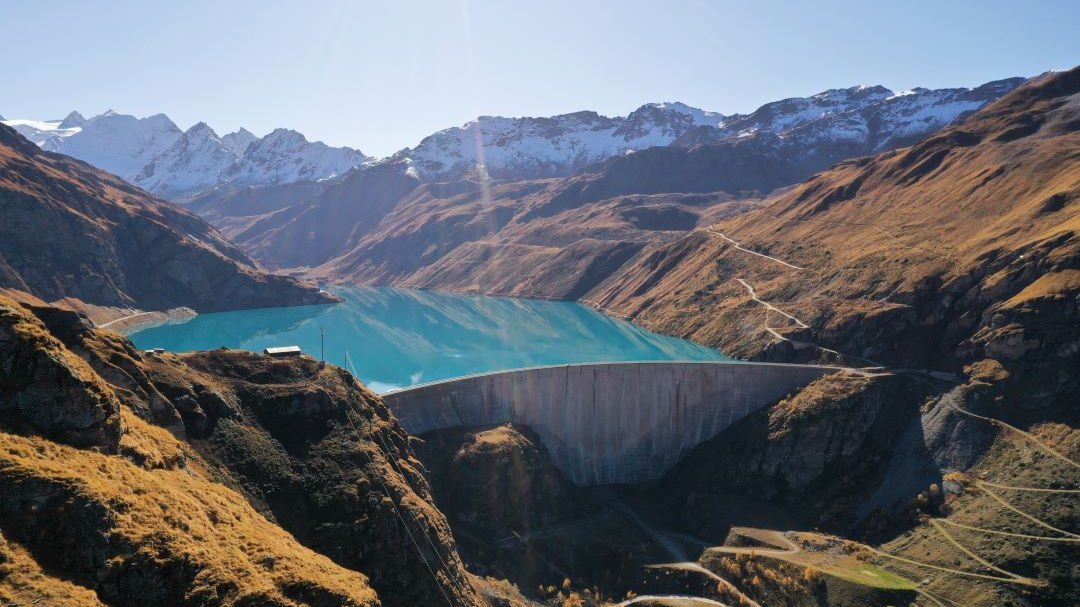The fact that reservoirs are full in late autumn is hugely significant for securing the electricity supply in Switzerland during the critical winter months. Climate change is causing the inlets into the reservoirs to change. This makes forecasts and, as a result, the work of the asset optimisers at Alpiq even more complex. They ensure that the stored water can be used in the best possible way for demand-oriented and cost-effective power production. But sometimes even their hands are tied. Raphael Mutzner, 37, explains the challenges associated with this important role for Switzerland security of supply.

Late autumn is probably the best time of year to travel beyond the fog line to a reservoir. Under blue skies, the sun ensures pleasant temperatures and the trees are verdantly reflected in the surface of the well-filled reservoirs.
But late autumn, in particular October and November, is the time of year that poses the greatest challenge to Raphael Mutzner in his day-to-day work. The physicist graduated from EPFL and now specialises in inflow forecasting. As an asset optimiser at Alpiq, his main task is to operate the hydropower plants and manage the content of its reservoirs as efficiently as possible, therefore ensuring the stored water is used in the best way possible. In carrying out this task, he can call on the knowledge he gained while working on his doctorate in hydrology and during his work placements, in particular his understanding for physical processes in the catchment area of the Alpiq hydropower plants and of how to interpret data from measuring stations.

Experience, modelling and weather forecasts
Raphael Mutzner and his colleagues use modelling and weather forecasts to predict how the inflows into the reservoir and, therefore, their fill level will develop. “Based on this, every day we set a range for Asset Trading indicating how much production capacity is currently available per hydropower plant,” he said. Asset Trading at Alpiq sells energy production from its own power plants on marketplaces across Europe. The traders use these binding specifications from Raphael Mutzner’s team to place offers on the market. If there is corresponding demand for the offers, the electricity is produced.
Maximum in November, lowest level in April
“The guideline for these specifications is that the water should be available when there is the most demand, the market prices are at their highest and the electricity from hydropower plants is at its most valuable for the security of supply,” said Raphael Mutzner. Reservoirs like Lake Dix (Grande Dixence), Moiry, Emosson or Salanfe should generally be at their highest level between October and November, so that electricity can be produced in line with consumer demand in winter months. The water levels are at their lowest level in April, as this is before the snow melts in the summer.

We continue to adjust the models to new developments. However, due to the effects of climate change, we will probably need to build larger and larger reserves in the future. Climate change is making our work more complex.
Until a few years ago, Raphael Mutzner primarily had to anticipate the seasonal snowmelt when making these calculations. Now, however, climate change is creating new conditions and increasing the requirements and complexity of accurate forecasts. “On the one hand, the snow line has risen sharply, while on the other hand, extreme weather events are becoming more frequent,” said the 37-year-old. And this is precisely what is posing the greatest challenges to the asset optimisation team in late autumn. For example, if a period of initial snowfall is followed by another thaw, possibly even paired with a heavy thunderstorm, this very quickly leads to high inflows into reservoirs that are already full at this time of year, as happened in November 2023. “In order to prepare and guard against such extreme situations, we build in a safety margin for the fill level,” said Mutzner.

Sometimes the reservoir is too small for the amount of meltwater
While the asset optimisers aim to actively manage most reservoirs, sometimes they have to stand aside as the water for power production flows downstream unused. The Gebidem reservoir is too small for the amount of water that accumulates. On hot days, the reservoir is unable to fully absorb the meltwater from the Aletsch glacier. “Even if we lower the reservoir level in advance and the turbines at the Bitsch power plant produce electricity at their maximum output, the reservoir continues to fill up until it overflows on those days,” said Raphael Mutzner. “That means the water is lost for energy production.” Climate change is making these days with overflows are increasingly common. In 2023, the water from the overflow could have been used to produce enough power to meet the annual electricity requirements of more than 9,000 households, and in 2024 for over 14,000 households. “The situation will only improve if we increase the storage capacity,” stated Raphael Mutzner. This is what is being planned with the Oberaltesch project, for example, which is one of the Hydropower Round Table projects. “Our main goal is to be able to use the reservoirs and potential inflows in the best possible way.”

The aim is to achieve a good compromise
The aim is to create the most accurate forecast possible and find a good compromise based on various data analyses. This means leaving some space in the reservoir for unexpected inflows while also avoiding the loss of winter energy and, therefore, value in the event of dry weather or if inflows fail to materialise. Because from a supply perspective, using the water for power production during the critical time of year between January and March is the desirable scenario. If Switzerland is unable to produce enough electricity itself, it must import power from abroad. “We continue to adjust the models to new developments. However, due to the effects of climate change, we will probably need to build larger and larger reserves in the future. Climate change is making our work more complex.”
